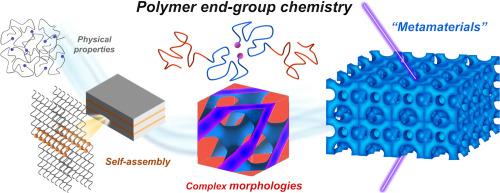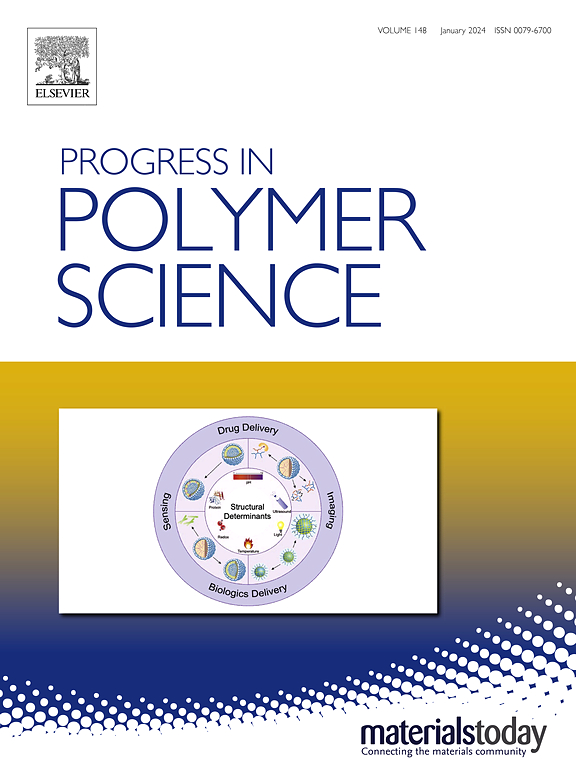Polymer Chain-End Chemistry: Unlocking Next-Generation Functional Materials
IF 26.1
1区 化学
Q1 POLYMER SCIENCE
引用次数: 0
Abstract
End-group functionalization has emerged as a powerful and versatile strategy in polymer science, offering precise control over physical properties, nanoscale self-assembly, and interfacial functionality without altering the polymer backbone. This review summarizes recent progress in the chemistry and applications of end-functionalized polymers across three thematic domains. First, we examine how tailored end groups influence intrinsic polymer properties, including thermal transitions, solubility, crystallization behaviors, and interfacial adhesion. Second, we explore the role of end-group interactions in directing polymer self-assembly, emphasizing their ability to modulate chain packing, interfacial curvature, and phase behavior in block copolymer systems, particularly in the formation of complex network morphologies. Third, we highlight the growing technological relevance of end-functionalized polymers with network morphologies in emerging applications such as solid-state battery electrolytes, mechanical metamaterials, and optical metamaterials. In polymer electrolytes, ion–dipole interactions localized at the chain termini decouple ion transport from segmental motion, yielding high ionic conductivity and low activation energy at low salt concentrations. In mechanical metamaterials, end-group-directed 3D networks enhance structural resilience and tunable deformation behavior. In optical metamaterials, metal-end-functionalized block copolymers could serve as nanoscale templates for the bottom-up fabrication of high-refractive-index architectures via metal–ligand coordination, tackling the resolution limits of top-down lithography. Collectively, these advances underscore the transformative potential of end-group chemistry for next-generation polymer materials.

聚合物链端化学:解锁下一代功能材料
端基功能化已经成为聚合物科学中一种强大而通用的策略,在不改变聚合物主链的情况下,提供对物理性质、纳米级自组装和界面功能的精确控制。本文综述了端功能化聚合物在三个领域的化学和应用方面的最新进展。首先,我们研究了定制的端基如何影响聚合物的固有性质,包括热转变、溶解度、结晶行为和界面粘附。其次,我们探索了端基相互作用在指导聚合物自组装中的作用,强调了它们在嵌段共聚物体系中调节链填充、界面曲率和相行为的能力,特别是在复杂网络形态的形成中。第三,我们强调了端功能化聚合物与网络形态在新兴应用中的技术相关性,如固态电池电解质、机械超材料和光学超材料。在聚合物电解质中,位于链末端的离子偶极子相互作用使离子传输与节段运动分离,在低盐浓度下产生高离子电导率和低活化能。在机械超材料中,端基定向三维网络增强了结构弹性和可调变形行为。在光学超材料中,金属端功能化嵌段共聚物可以作为纳米级模板,通过金属配体配位自下而上地制造高折射率结构,解决了自上而下光刻的分辨率限制。总的来说,这些进步强调了端基化学在下一代聚合物材料中的变革潜力。
本文章由计算机程序翻译,如有差异,请以英文原文为准。
求助全文
约1分钟内获得全文
求助全文
来源期刊

Progress in Polymer Science
化学-高分子科学
CiteScore
48.70
自引率
1.10%
发文量
54
审稿时长
38 days
期刊介绍:
Progress in Polymer Science is a journal that publishes state-of-the-art overview articles in the field of polymer science and engineering. These articles are written by internationally recognized authorities in the discipline, making it a valuable resource for staying up-to-date with the latest developments in this rapidly growing field.
The journal serves as a link between original articles, innovations published in patents, and the most current knowledge of technology. It covers a wide range of topics within the traditional fields of polymer science, including chemistry, physics, and engineering involving polymers. Additionally, it explores interdisciplinary developing fields such as functional and specialty polymers, biomaterials, polymers in drug delivery, polymers in electronic applications, composites, conducting polymers, liquid crystalline materials, and the interphases between polymers and ceramics. The journal also highlights new fabrication techniques that are making significant contributions to the field.
The subject areas covered by Progress in Polymer Science include biomaterials, materials chemistry, organic chemistry, polymers and plastics, surfaces, coatings and films, and nanotechnology. The journal is indexed and abstracted in various databases, including Materials Science Citation Index, Chemical Abstracts, Engineering Index, Current Contents, FIZ Karlsruhe, Scopus, and INSPEC.
 求助内容:
求助内容: 应助结果提醒方式:
应助结果提醒方式:


